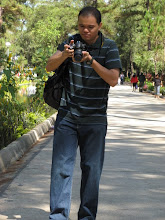Article: Something of the Glory of God Shines on Your Face
If we lined up all the major issues of Catholic social teaching and compared them to the Himalayas, the "dignity of the human person" would be Mount Everest – the most magnificent and tallest peak dwarfing the rest.
 |
All other social teachings fall under the shadow cast by the dignity of the human person. Not only that, but all other social actions gain their legitimacy from how well they affirm the dignity of the human person.
There are two major reasons why this is true.
But first, here's a little riddle from catechism class that will help us uncover the reason: What are the only man-made things in heaven? Take your time. Puzzle it out. We can wait . . .
Answer: The nail prints on the hands and feet of Jesus, and the scar in his side.
Why?
Jesus still has a human body. The omnipotent, omniscient, omnipresent almighty Savior of the World still has a human body, albeit a glorified one.
The post-resurrection gospel accounts verify its amazing properties: walking through walls, startling appearances and disappearances (Cf. Lk. 24:31, 36-43; Jn. 20:19-20). Most famously Jesus appeared to Thomas and the apostles, permitting Thomas to probe the nail prints to assuage his doubt (Cf. Jn. 20:24-29).
"The Word became flesh" (Cf. Jn. 1:14). The Son of God incarnate is both God and man.
The Catechism of the Catholic Church, par. 469 and 470:
The Church thus confesses that Jesus is inseparably true God and true man. He is truly the Son of God who, without ceasing to be God and Lord, became a man and our brother . . .
The Son of God . . . worked with human hands; he thought with a human mind. He acted with a human will, and with a human heart he loved. Born of the Virgin Mary, he has truly been made one of us, like to us in all things except sin.
Even now, that mystical Body is united with the Trinity. The body of Jesus was not some kind of disposable earthly transport vehicle. No. Jesus completely united himself to humanity in a permanent way.
It is particularly relevant to the "respect life" issues – to respect the life of the body and care for the dignity of the human person in every circumstance of natural life, for the body is also a temple of the Holy Spirit (Cf. 1 Cor. 3:16). The most powerful sign we have of that is that Jesus, God Himself, took on a body.
The humanity of Jesus signals to us the deep meaning of the human person. "Christ by his incarnation has united himself in some fashion with every person" (Gaudium et Spes, par. 22.).
That is the second reason why the dignity of the human person is thus elevated in the hierarchy of social teaching. (And I'm guessing you might already know the first . . .)
All other teachings flow out and radiate from these core values. |
Therefore, via the Incarnation, one might say that God took on the image and likeness of a man.
Hey, wait a minute – Doesn't that sound a bit like Genesis 1:26-27?
The first Creation account declares man and woman were made in the "image" and "likeness" of God! Human persons being made in the image of God precedes the Incarnation of Jesus.
This is the first reason why human dignity is the primordial foundation to all social teachings. Humanity made in the image and likeness of God, and God being made in the image of a man is part of God's plan to redeem humanity; these inner truths unlock the richness of Catholic social teaching. All other teachings flow out and radiate from these core values.
Since something of the glory of God shines on the face of every person, the dignity of every person before God is the basis of the dignity of man before other men (Compendium of Catholic Social Teaching, No. 144).
Indeed, that is a more profound view of humanity and the world than one might see from the pinnacle of Everest.
![]()
ACKNOWLEDGEMENT
Pat Gohn. "Something of the Glory of God Shines on Your Face." Patheos (April 13, 2011).
Reprinted with permission of Patheos.
Founded in 2008, Patheos.com is the premier online destination to engage in the global dialogue about religion and spirituality and to explore and experience the world's beliefs. Patheos is unlike any other online religious and spiritual site and is designed to serve as a resource for those looking to learn more about different belief systems, as well as participate in productive, moderated discussions on some of today's most talked about and debated topics..
THE AUTHOR
Pat Gohn is a writer, speaker, and host of the "Among Women" podcast and blog. She holds a Masters in Theology, and a Bachelors in Communications. Her passion is working within Catholic adult faith formation and using media for evangelization and catechesis. Find out more at Find out more at PatGohn.com.
Copyright © 2011 Patheos



0 Comments:
Post a Comment
<< Home